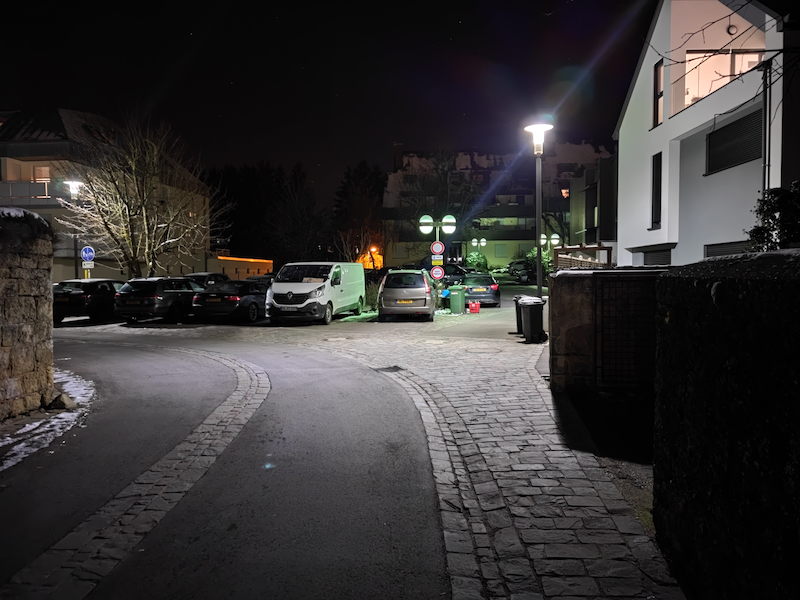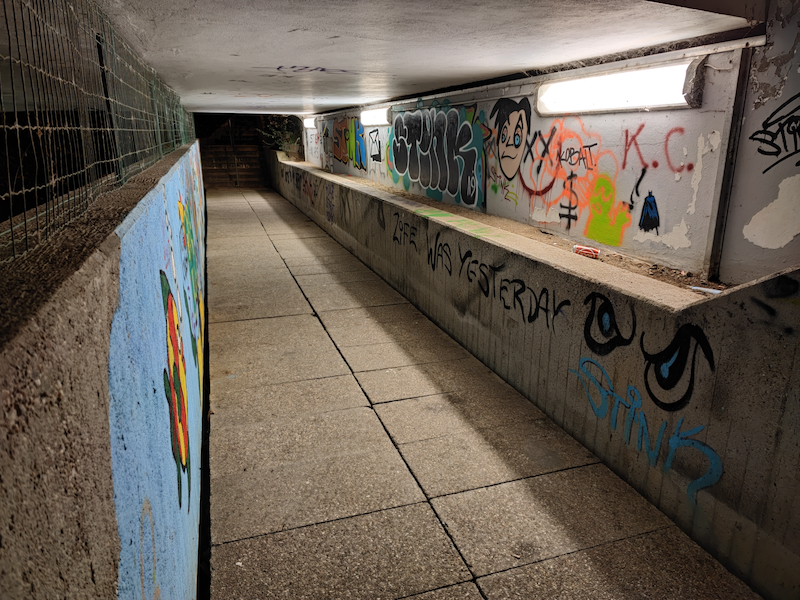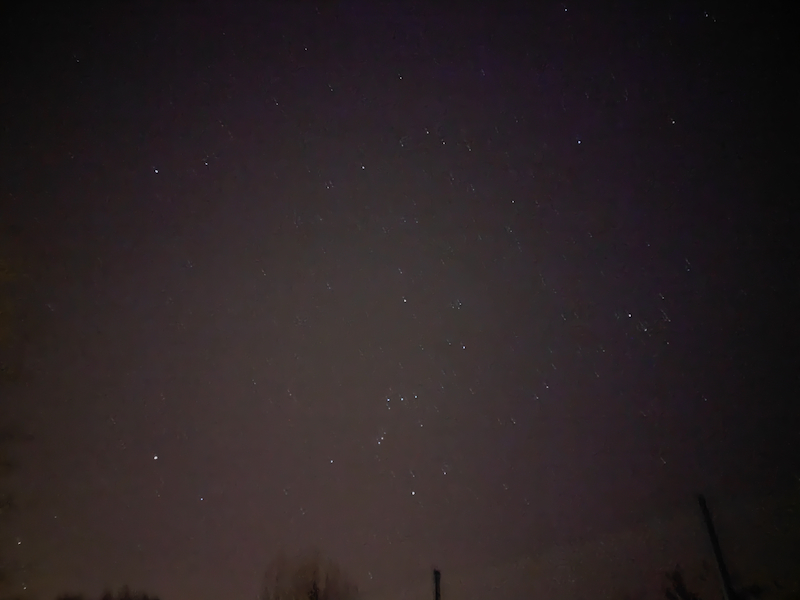The Xiaomi Mi 11 Review: A Gorgeous Screen and Design
by Andrei Frumusanu on March 10, 2021 8:00 AM EST- Posted in
- Mobile
- Smartphones
- Xiaomi
- Snapdragon 888
- Mi 11
Camera - Low Light Evaluation
Low-light photography of the Mi 11 on paper shouldn’t be exactly a strong-point of the device: Due to the way the main sensor is 2x2 binning to 27MP at the lowest resolution, it means that it effectively has smaller pixels than comparable 12MP shooters, or even the other 1/1.3”-class sensors from Samsung or even Huawei. On top of this, the Mi 11 has a smaller aperture versus the Mi 10 Pro in the optics. Still, the new phone has a newer SoC so maybe there’s some new processing algorithms which could come to play in terms of generationally improving the low-light capabilities of the phone.

[ Mi 11 - ] [ Mi 10 Pro - ]
[ S21U(S) - ] [ S21U(E) - ]
[ S21(E) - ] [ S20+(E) - ]
[ Note20U(S) - ] [ iPhone 12 Pro - ]
[ Mate40 Pro - ] [ Pixel 5 - ]
[ X-T30 ( ) ]
In the first scene here, we see a very different result when looking at the Mi 11 compared to the Mi 10 Pro, and it’s actually not a positive one. The Mi 11 regresses in terms of dynamic range, posting brighter highlights (than they should be) and darker shadows with less detail. The EXIF says the Mi 11 had a twice as long exposure – though the loss of detail in the shadows points out that the night mode processing is very different.
Although the Mi 11 has strong natural detail retention, the competition just does better in terms of bringing out details in the darkness.
The ultra-wide’s night mode hardly makes any difference on the Mi 11 which is a bit weird, as the Mi 10’s was quite adequate.

[ Mi 11 - ] [ Mi 10 Pro - ]
[ S21U(S) - ] [ S21U(E) - ]
[ S21(E) - ] [ S20+(E) - ]
[ Note20U(S) - ] [ iPhone 12 Pro - ]
[ Mate40 Pro - ] [ Pixel 5 - ]
[ X-T30 ( ) ]
In terms of colour temperature, the Mi 11 was quite off in terms of the magenta hue. Where’s still reasonable amount of even light, the Mi 11 again does really well with details due its higher resolution sensor.

[ Mi 11 - ] [ Mi 10 Pro - ]
[ S21U(S) - ] [ S21U(E) - ]
[ S21(E) - ] [ S20+(E) - ]
[ Note20U(S) - ] [ iPhone 12 Pro - ]
[ Mate40 Pro - ] [ Pixel 5 - ]
[ X-T30 ( ) ]
Here, although the Mi 11 overdid it in terms of the colour temperature compensation and really isn’t representative of the hue of the sodium vapour lamps, the Mi 11 still somehow manages a very good compositions in the tone curves.

[ Mi 11 - ] [ Mi 10 Pro - ]
[ S21U(S) - ] [ S21U(E) - ]
[ S21(E) - ] [ S20+(E) - ]
[ Note20U(S) - ] [ iPhone 12 Pro - ]
[ Mate40 Pro - ] [ Pixel 5 - ]
[ X-T30 ( ) ]
In terms of raw dynamic range in night mode, the Mi 11 doesn’t fare as well as some of the competition, however it’s still above average, and it does a much better tone-mapping than the Mi 10, maintaining better mid-tone contrast whereas the predecessor tended to make things very flat.

[ Mi 11 ] [ Mi 10 Pro ]
[ S21U(S) ] [ S21U(E) ]
[ S21(E) ] [ S20+(E) ]
[ Note20U(S) ] [ iPhone 12 Pro ]
[ Mate40 Pro - ] [ Pixel 5 ]
[ X-T30 ( ) ]
In even more low-light conditions, the Mi 11 does very well in the overall scene. The phone prefers to bring out shadows rather than maintaining highlight details, but that’s generally acceptable for the end-result.
Unfortunately the ultra-wide isn’t really usable here, the Samsung phones and their superior sensor as well as Huawei are well ahead in terms of quality.

[ Mi 11 ] [ Mi 10 Pro ]
[ S21U(S) ] [ S21U(E) ][ S21(E) ] [ S20+(E) ] [ Note20U(S) ]
[ iPhone 12 Pro ] [ Mate40 Pro - ] [ Pixel 5 ]
[ X-T30 ( ) ]
Finally, a scene that I did just for fun was the night sky when in handheld mode. It’s not really a realistic shooting mode, but it does show some of the processing styles of the phones. The Mi 11 has better noise control than the Mi 10 but due to the exposure being twice as long we’re seeing obvious ghosting and mirror images in the stars – either that, or the image stacking algorithm from Xiaomi isn’t quite as strong as the competition.
Low-light verdict: Not the best, but still quite good
The general conclusion for low-light capabilities of the Mi 11 is that it’s a plenty adequate shooter with some strengths as well as some weaknesses. Xiaomi’s processing isn’t quite as strong as Samsung’s, but does better than other vendors bar Huawei. The capabilities of the sensor are still plenty, and in general it’s a competent shooter. On the ultra-wide module however, the sensor really is far too weak, and even night mode cannot save it, producing images that are far too dark and barely usable compared to other high-end competitors.










85 Comments
View All Comments
ZoZo - Wednesday, March 10, 2021 - link
Curved edge screen? Next.yankeeDDL - Wednesday, March 10, 2021 - link
Really? Why? I have an S8 (yes, Samsung S8, 4 years old and counting) with edge screen. It still works perfectly, it is a pleasure to hold and it has some decent edge effects that are actually useful.I'd definitely consider another phone with curved edges.
I look forward to something a tad smaller than this though: 6" for example.
I hate the fact that on Android if you want the top of the line HW you get it only on huge phones.
Wereweeb - Wednesday, March 10, 2021 - link
Because it's terrible to use and distorts images. It's stupid and should stop existing. I say this as a former S6 Edge user (I didn't buy it, it was handed down to me)theblitz707 - Friday, March 26, 2021 - link
thats your opinion. i never had a problem with my curves s10+ and quite like it, it makes the screen look more premium and i never felt a distortion problem when watching videos. in fact compared to 11 pro max, that looks like a phone from years ago.inighthawki - Wednesday, March 10, 2021 - link
Am I the only one who prefers a phone with a flat rectangle for a screen with no curves, notches, or rounded corners cutting off or warping various parts of the display?Wereweeb - Wednesday, March 10, 2021 - link
Eh, rounded corners makes it easier to hold, and doesn't really compromise images that much. I'll take notches over hidden cameras, but otherwise I also dislike them, and prefer pop-up cameras or a camera between the housing and the display.inighthawki - Thursday, March 11, 2021 - link
I guess I mean that I'm fine with having a bezel on the top/bottom for that kind of thing. The phone itself can still have some roundedness on the corners. For example right now I use a pixel 2 and love it. I think they could shrink the bezels without sacrificing the screen being a rectangle.And while the corners dont really compromise much, it's something that forces software developers to work around. For example, if you're right a game, you now have to query APIs to know how rounded the corners are to ensure you aren't putting text or status icons somewhere the user can't see. Like imagine if your desktop's monitor had rounded corners and it forced Microsoft to update the taskbar so that the start button wasn't flush against the edge. It serves no purpose. You're quite literally just losing functionality. And on a phone it's done for no other reason than the bragging rights of claiming the display is 0.2" larger than the previous generation with zero bezels.
inighthawki - Thursday, March 11, 2021 - link
If you're writing a game*Stupid no edit button :(
hanselltc - Thursday, March 11, 2021 - link
minor curved corners are acceptable if it truly helps the phone keep a more handleable shape. if it has a chin and/or a forehead, then it is stupid. other cutouts are all absolutely asinine.MetaCube - Thursday, March 18, 2021 - link
Rounded corners are great, stop smoking glue